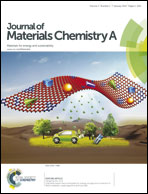New conjugated alternating benzodithiophene-containing copolymers with different acceptor units: synthesis and photovoltaic application
Abstract
Two new alternating low band gap D–A copolymers with different acceptor structures of 4,8-bis-(5-bromothiophene-2-yl)-benzo[1,2,5]thiadiazole (P1) and 4,8-dithiophene-2-yl-benzo[1,2-c;4,5-c′]-bis-[1,2,5]thiadiazole (P2) and a common BDT donor segment have been synthesized under Stille reaction conditions and characterized. The polymers showed good solubility, broad absorption bands and optical band gaps of 1.62 eV and 1.16 eV for P1 and P2, respectively. Bulk heterojunction (BHJ) polymer solar cells based on P1 and P2 as electron donors and fullerene derivatives (PC60BM and PC70BM) as acceptor were fabricated and their photovoltaic response was investigated. The overall power conversion efficieny (PCE) achieved for BHJ solar cells based on P1:PC60BM, P2:PC60BM, P1:PC70BM and P2:PC70BM blends cast from THF solvent is about 2.17%, 0.80%, 3.45% and 1.19%, respectively. The higher PCE for the device based on P1 has been attributed to the high value of hole mobility for P1 as compared to P2 and a larger driving force i.e. LUMO–LUMO offset, for photo-induced charge transfer for P1:PCBM BHJ active layer. The PCE has been further increased up to 5.30% and 1.58% for P1:PC70BM and P2:PC70BM blends cast from DIO/THF solvent, which is attributed to the improved crystallinity and a more balanced charge transport in the device.


 Please wait while we load your content...
Please wait while we load your content...